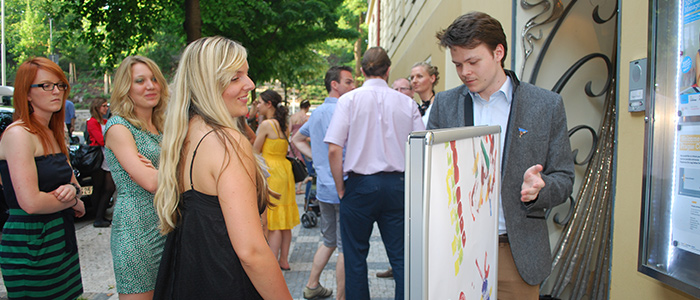Hybernská Street: A Fascinating History
By Larissa Petryca on 27 December 2023 15:12
Last updated on 10 January 2024 12:01
In January 2023, we left our founding campus at Polská street in Vinohrady and moved to the City Centre Campus in Hybernská street. Hybernská street has a significant history as it was the main thoroughfare into Prague from the royal town of Kutná Hora.
Kutná Hora
Centuries ago, Kutná Hora was the second most important town after the royal City of Prague. Silver had been discovered in the late 10th century, followed by a mining boom which over time brought much wealth to the town and elevated the Czech kingdom to new levels of power within Europe. The town also became the seat of the central mint and the financial centre for the Czech lands.
The Main Thoroughfare
Because this street connected Prague with the royal town of Kutná Hora, it was known in mediaeval times simply as Horská. An alternative name, Dlážděná, is a reminder that it was also one of the first paved streets in the city.
In 1355, Charles IV allowed monks from the Order of Saint Ambrose to settle at the western end of the street, opposite where the Powder Gate would eventually be built, this led the street to be known for a period of time as Svatoambrožská. In 1629 this monastery passed into the hands of Franciscan monks from Ireland who, amongst other innovations, cultivated the first potatoes in Bohemia.
The Latin name for Ireland is Hibernia; so, when the Franciscans returned to Ireland in 1786 following the limiting of Catholic power by the emperor Joseph II, the street became known as Hybernská (Irish street). The monastery was remodelled several times, and is now a musical theatre, also known as the Hibernia.

Hybernská Centrum
The City Centre Campus is within the Hybernská Centrum building which was built between 1928 and 1932 by the architect Pavel Moravec (1891-1979). During the golden age of Czechoslovakia’s First Republic, Moravec, along with his partner Tomáš Pražák (1890-1947) was responsible for several other modernist buildings in Prague, including the Hasičský dům (Fire Brigade House, fig 2) close to PCU’s founding campus in Vinohrady, and a hotel (today the Hotel Harmony) on the corner of Biskupská, near PCU Bishop’s Court campus. Moravec and Pražák went on to build a number of private villas built in the so-called ‘national style’ in the 1930s in the upmarket district of Bubeneč, Prague 6.

Hybernská Centrum originally housed a hotel, as well as residential and office spaces. The rooms overlooking Hybernská street on the first floor and to the right of the reception once housed a theatre cafe with a stage. You can still see the stage’s crown mouldings in PCU’s Meeting Room 101, underneath of which many performances would have taken place.

Written in collaboration with Alex Went, author of The Prague Vitruvius.
- School of Art, Design & Media (433)
- Student Life (331)
- School of Business, Management & Technology (268)
- Global Engagement (141)
- Research & Creative Practice (95)
- Seminars & Workshops (73)
- Master Speakers Series (70)
- Exhibitions (69)
- New Students (64)
- Academic Partners (58)
- Alumni (58)
- Living Futures (52)
- Graduation (47)
- Visiting Artist Lecture Series (44)
- Conferences (37)
- Digital Campus (22)
- Professional Partners (14)
- Study Exchanges (14)
- University News (11)
- Industry Network (9)
- School of Education (9)
- Media Innovation Technology Series (8)
- Press Release (8)
- Erasmus+ (3)
- Student Societies (1)
- May 2025 (2)
- April 2025 (4)
- February 2025 (4)
- January 2025 (5)
- December 2024 (2)
- November 2024 (1)
- October 2024 (2)
- September 2024 (6)
- August 2024 (4)
- July 2024 (4)
- May 2024 (1)
- April 2024 (1)
- March 2024 (2)
- February 2024 (1)
- January 2024 (3)
- December 2023 (1)
- November 2023 (3)
- October 2023 (1)
- September 2023 (1)
- August 2023 (1)
- July 2023 (2)
- June 2023 (1)
- April 2023 (2)
- March 2023 (2)
- February 2023 (3)
- January 2023 (2)
- December 2022 (5)
- November 2022 (3)
- September 2022 (4)
- August 2022 (2)
- July 2022 (2)
- June 2022 (1)
- May 2022 (7)
- April 2022 (5)
- March 2022 (5)
- February 2022 (3)
- January 2022 (1)
- December 2021 (7)
- November 2021 (8)
- October 2021 (6)
- September 2021 (5)
- August 2021 (8)
- July 2021 (3)
- June 2021 (3)
- May 2021 (2)
- April 2021 (5)
- March 2021 (3)
- February 2021 (4)
- January 2021 (2)
- December 2020 (5)
- November 2020 (8)
- October 2020 (2)
- September 2020 (3)
- August 2020 (1)
- July 2020 (3)
- June 2020 (4)
- May 2020 (7)
- April 2020 (6)
- March 2020 (5)
- February 2020 (2)
- January 2020 (7)
- December 2019 (5)
- November 2019 (12)
- October 2019 (9)
- September 2019 (6)
- July 2019 (1)
- June 2019 (1)
- May 2019 (14)
- April 2019 (10)
- March 2019 (7)
- February 2019 (16)
- January 2019 (8)
- December 2018 (2)
- November 2018 (6)
- October 2018 (10)
- September 2018 (3)
- August 2018 (2)
- July 2018 (3)
- June 2018 (10)
- May 2018 (12)
- April 2018 (9)
- March 2018 (5)
- February 2018 (3)
- January 2018 (8)
- December 2017 (4)
- November 2017 (9)
- October 2017 (7)
- September 2017 (3)
- July 2017 (4)
- June 2017 (3)
- May 2017 (8)
- April 2017 (8)
- March 2017 (13)
- February 2017 (11)
- January 2017 (6)
- December 2016 (3)
- November 2016 (18)
- October 2016 (9)
- September 2016 (8)
- August 2016 (4)
- July 2016 (9)
- June 2016 (3)
- May 2016 (6)
- April 2016 (5)
- March 2016 (78)
- February 2016 (4)
- January 2016 (4)
- December 2015 (6)
- November 2015 (9)
- October 2015 (5)
- September 2015 (6)
- August 2015 (1)
- July 2015 (4)
- June 2015 (1)
- May 2015 (3)
- April 2015 (11)
- March 2015 (6)
- February 2015 (6)
- January 2015 (6)
- December 2014 (1)
- November 2014 (17)
- October 2014 (4)
- September 2014 (8)
- August 2014 (5)
- July 2014 (1)
- June 2014 (10)
- May 2014 (25)
- April 2014 (32)
- March 2014 (53)
- February 2014 (25)
- January 2014 (10)
- December 2013 (10)
- October 2013 (1)
- September 2013 (1)
- July 2013 (4)
- June 2013 (2)
- March 2013 (2)
- February 2013 (74)
- January 2013 (6)
- December 2012 (13)
- November 2012 (3)
- October 2012 (5)
- September 2012 (156)
- July 2012 (1)
- November 2011 (1)
- November 2010 (1)
- November 2009 (1)
- November 2008 (4)
- September 2008 (1)
- July 2008 (1)
- June 2008 (4)
- May 2008 (2)
- April 2008 (3)
- March 2008 (2)
- February 2008 (1)
- December 2007 (1)
- October 2007 (1)
- August 2007 (1)
- July 2007 (1)
- June 2007 (4)
- May 2007 (1)
- April 2007 (2)
- March 2007 (3)
- January 2007 (1)
- November 2006 (1)
- December 2005 (1)
- November 2005 (1)
- October 2005 (1)
- August 2005 (1)
- May 2005 (1)
You May Also Like
These Related Articles

Summer Intensive students, welcome!

Jan Rosický, Prague College student wins top UK design prize

